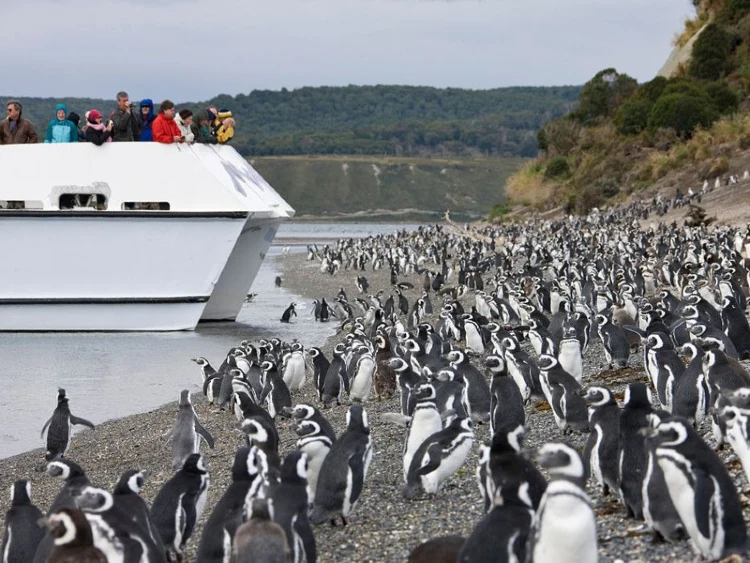This July, approximately 2,000 Magellanic penguins were discovered dead along the Uruguayan beaches, revealing starved and alarmingly emaciated conditions.
Carmen Leizagoyen from Uruguay’s Environment Ministry commented to AFP, “It’s an aquatic mortality event.” She further noted, “The vast majority are young penguins arriving with no fat stores and completely empty stomachs.”
While the exact reason for this large-scale death remains elusive, the alarm bells are ringing about possible links to significant climate shifts, which might be speeding up the downfall of this penguin species.
Magellanic penguins, classified as ‘near threatened’ since 2004, have faced multiple such unfortunate events in the last three decades along South America’s eastern coast. Notably, 2010 saw over 550 penguins starve to death in Brazil, while in 2012, 745 more met a similar fate. These events have varied causes – from temperature spikes, like the 2019 incident where 354 penguins perished due to a heatwave in Argentina, to hypothermia, storms, or hunger.
The migratory patterns of these penguins could shed some light on these tragedies. They typically nest in southern Argentina during summer, but venture north in the colder months, seeking food and warmer waters. While it’s expected for a few young ones to not survive the journey, the recent mortality rates are alarmingly high.
Some experts theorize that a subtropical cyclone near Uruguay might have further strained an already famished penguin population this year. This theory gains traction when considering that other marine species, including turtles and sea lions, were also found dead in nearby regions.
While tests have ruled out avian flu in the recently discovered deceased penguins, their long-empty stomachs, and unexpectedly non-greasy feathers, crucial for insulation and water resistance, point to extreme distress.
SOS Rescate de Fauna Marina, an animal welfare group, speculates on Facebook, “The dual effects of South Atlantic overfishing and climate-induced offshore current shifts might be behind this tragedy.” They added, “Storm influences are possible, but the underlying factor seems to be their weakened state that couldn’t withstand adverse conditions.”
Since the ’90s, challenges in finding food have plagued these penguins. Yet, little has been accomplished to sustain their primary food sources like anchovies and sardines. Overfishing and climate-induced shifts in marine life distribution are primary culprits.
Worryingly, breeding pairs of these penguins in Argentina have dwindled from 300,000 in the 1990s to a mere 200,000 by 2009. If current trends persist, these tragic mass deaths might sadly become a regular occurrence.

The Ecological Importance of Magellanic Penguins: Why They Would Be Missed
Magellanic penguins, beyond their iconic black and white plumage, play an integral role in the delicate balance of their ecosystem.
Here’s why these creatures are indispensable and the void their extinction would create:
They Help Maintain The Natural Predator-Prey Balance
Magellanic penguins primarily feed on small fish like anchovies and sardines, helping regulate their populations. By controlling the numbers of these fish, penguins ensure that there isn’t overpopulation, which could destabilize the marine food web by leading to overgrazing on plankton and other smaller organisms.
They’re Beneficial Nutrient Recyclers
Just like any species in an ecosystem, penguins contribute to nutrient recycling. Their excrement, known as guano, is rich in nitrogen and phosphorus. When deposited on land, these nutrients are reintroduced into the soil, promoting plant growth. In turn, this supports bird species that rely on vegetation for nesting and sustenance.
These Penguins Are An Important Indicator Species
Penguins, due to their reliance on both marine and terrestrial habitats, serve as valuable indicator species. Their health, behavior, and population dynamics can offer insights into the overall health of the ecosystem.
Declines in penguin populations can be early warnings of bigger environmental problems that might otherwise go unnoticed until it’s too late.
They Have High Economic and Educational Value Throughout South America
Magellanic penguins are a significant attraction for ecotourism in regions like Argentina and Chile.
Their presence not only boosts local economies but also offers educational experiences for visitors, fostering a deeper appreciation for marine conservation.

They’re Powerful Biodiversity Promoters
Penguins are part of a rich marine and coastal ecosystem, which includes a myriad of species from seals and orcas to various bird species. Their presence ensures biodiversity, which is essential for ecosystem resilience in the face of changing environmental conditions.
If Magellanic penguins were to go extinct, not only would we lose an iconic species, but there would be a cascading effect throughout their ecosystem. Their absence would disrupt the balance, leading to unforeseen consequences in both marine and coastal environments. It’s a stark reminder of the interconnectedness of life and the importance of every species in preserving the rich tapestry of our planet.
About Magellanic Penguins
The Magellanic penguin, donning a striking black and white coat, is deeply intertwined with both historical voyages and the cinematic world. Discovered by the Portuguese explorer Ferdinand Magellan during his global expedition in the 16th century, these penguins proudly bear his name. Predominantly found gracing the coasts of Argentina and Chile, they also inhabit regions like the Falkland Islands and parts of Brazil.
Characterized by dual black bands across their bellies and their unique, braying calls reminiscent of a donkey, these medium-sized penguins have won the hearts of many. They nest intriguingly in burrows and shrubs, displaying captivating social rituals during their breeding season. The annual migration of these birds spans thousands of miles, as they traverse between breeding and wintering locales in the vast South Atlantic.
The charm of the Magellanic penguin has not escaped popular culture. They’ve appeared in films and documentaries highlighting the beauty and challenges of the natural world.
Notably, they were showcased in the documentary “Penguins: Spy in the Huddle”, which employed disguised cameras to offer intimate views of penguin life.
In the realm of animation, while not always accurately represented as Magellanic penguins (that’s Hollywood for you!), penguin characters in movies like “Happy Feet” and “The Pebble and the Penguin” draw inspiration from species like them, bringing the allure of these seabirds to audiences worldwide.
The Magellanic penguins are not just historical marvels, but also cultural icons, showcasing nature’s brilliance and the enduring human fascination with the avian world.



















